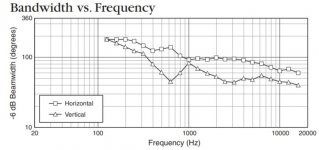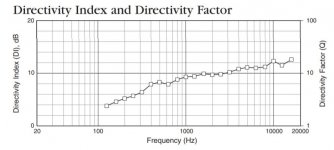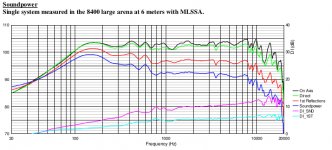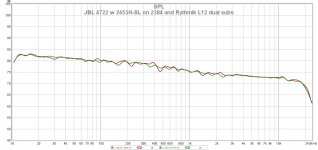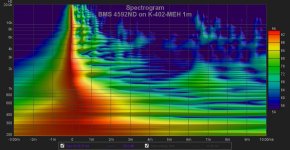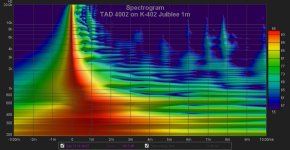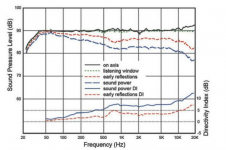I thought you wanted a uniform directivity. Vertically the 2384 looses its directivity already below 2500 Hz. Horizontally the directivity is fairly constant to 1000 Hz.
By the way, people seem to forget the vertical beamwidth.
hmm as the specs of all the horns are presented in different ways here I'm getting confused about the relative merits so I'm going to have a go at converting them to JBL style -6dB contours for comparison.
Omholt, not sure where you are getting your 2384 measurements from... Can you share? What CD was used? Btw, the JBL D2 on the 2384 is a poor match.
From JBL's specs:
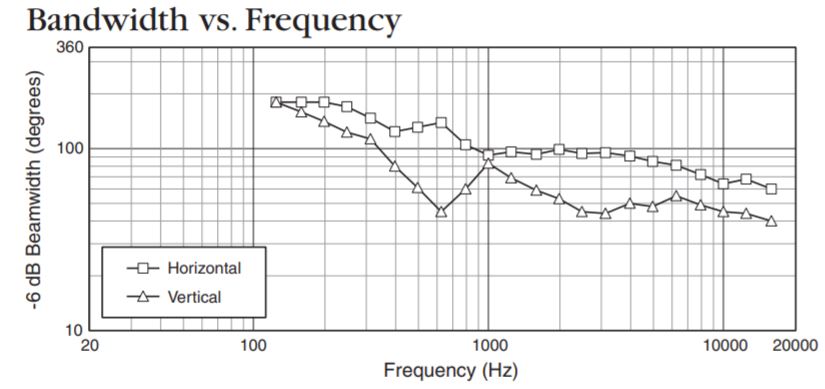
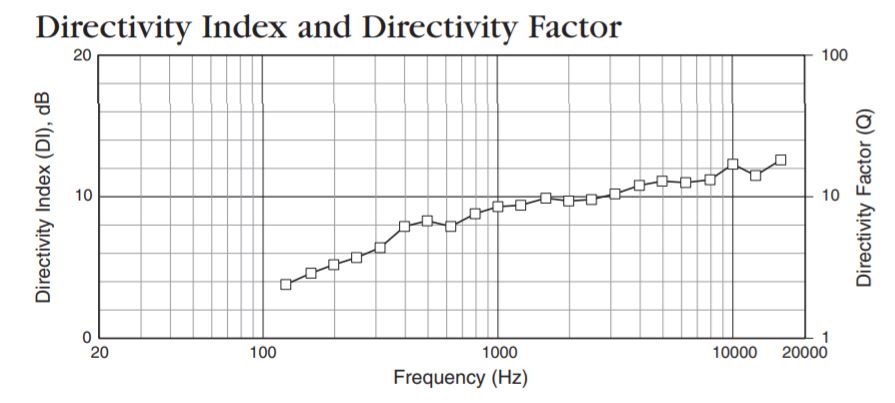
And a spinorama of the sound power both on and off axis:
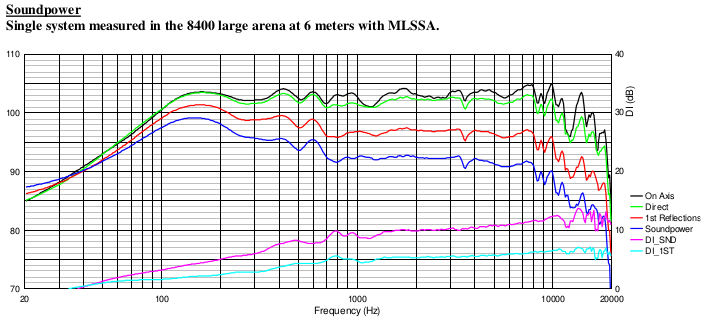
Other than a blip at 1 kHz on the vertical directivity, I don't see or hear any issues. It is a 90 x 50 asymetrcial waveguide and I have been listening to it for a while. Sounds pretty good no matter where I sit on my couch. With the 1.5" exit drivers, you are going to see some ripples in the frequency response beyond 10 kHz, but depending on which CD you are using will vary and if you are using DSP, can be corrected.
I tried several XO points, but found as I moved away from the recommended 630 Hz biamp point, the image would shift up more towards the waveguide. The 630 Hz active XO point blends perfectly between the bass cabs and the waveguides and the image is dead center between the top 15" woofer and waveguide.
@kipman725, I wrote a couple articles using DSP for a biamp and then adding subwoofers. I am pretty happy with the overall system response, measured at the LP:
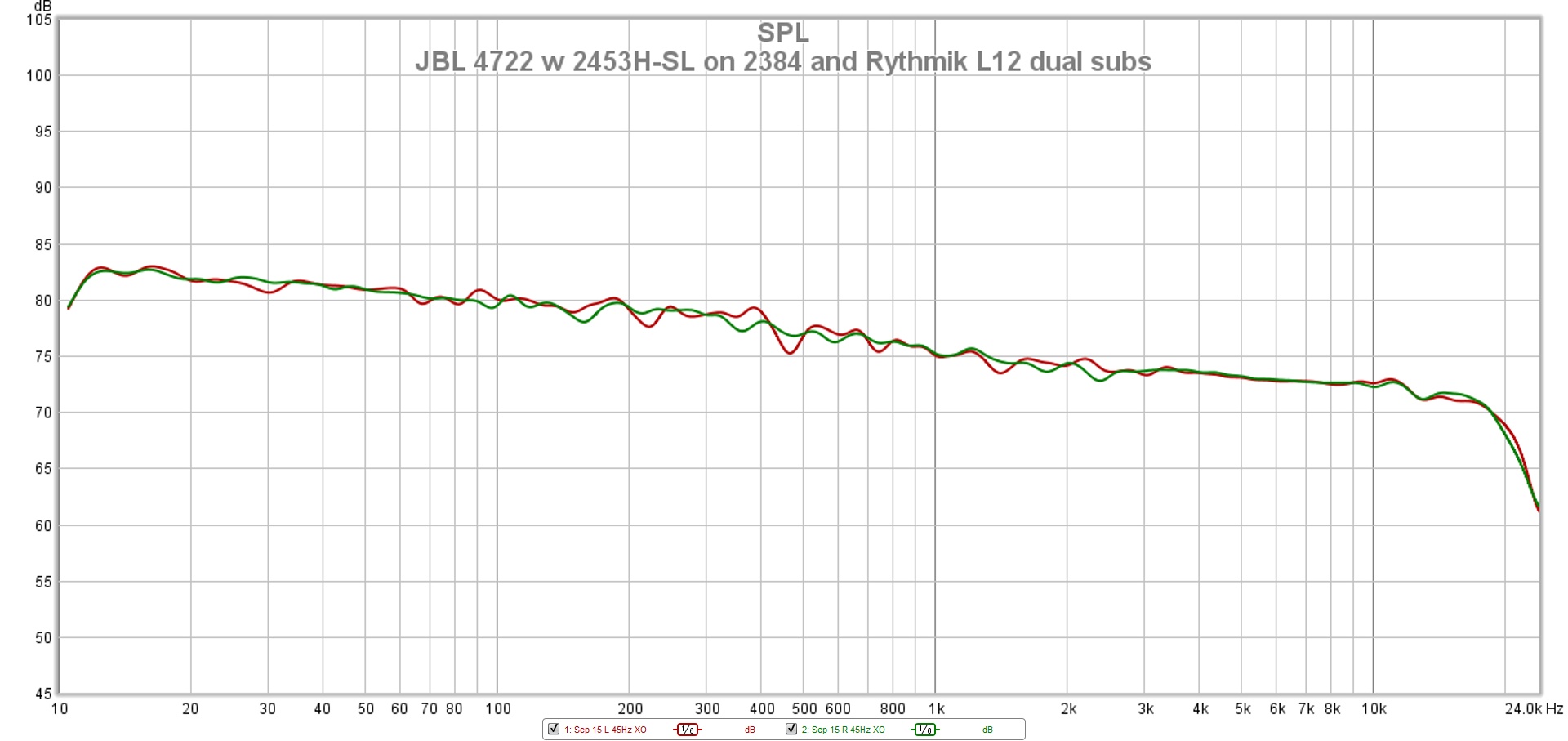
If wondering why the downward tilt, there is good research on what a good in-room response looks like based on anechoic measurements. Also, there are plenty of other measurements on the 2384 using different compression drivers on this long thread at: Just purchased a pair of JBL 4722n speakers. - AVS Forum | Home Theater Discussions And Reviews
Not looking for an argument, I am genuinely looking for a better waveguide than the 2384 and hence joining this thread on larger waveguides that can be purchased. I am all ears But certainly want to see some measurements...
But certainly want to see some measurements...
From JBL's specs:
And a spinorama of the sound power both on and off axis:
Other than a blip at 1 kHz on the vertical directivity, I don't see or hear any issues. It is a 90 x 50 asymetrcial waveguide and I have been listening to it for a while. Sounds pretty good no matter where I sit on my couch. With the 1.5" exit drivers, you are going to see some ripples in the frequency response beyond 10 kHz, but depending on which CD you are using will vary and if you are using DSP, can be corrected.
I tried several XO points, but found as I moved away from the recommended 630 Hz biamp point, the image would shift up more towards the waveguide. The 630 Hz active XO point blends perfectly between the bass cabs and the waveguides and the image is dead center between the top 15" woofer and waveguide.
@kipman725, I wrote a couple articles using DSP for a biamp and then adding subwoofers. I am pretty happy with the overall system response, measured at the LP:
If wondering why the downward tilt, there is good research on what a good in-room response looks like based on anechoic measurements. Also, there are plenty of other measurements on the 2384 using different compression drivers on this long thread at: Just purchased a pair of JBL 4722n speakers. - AVS Forum | Home Theater Discussions And Reviews
Not looking for an argument, I am genuinely looking for a better waveguide than the 2384 and hence joining this thread on larger waveguides that can be purchased. I am all ears
Attachments
The beamwidth and directivity index you showed are just confirming what I said. It also shows the horn has a closer to a 100° horizontal coverage. The vertical is all over the place and not constant. The horizontal uniformity is also a clear step back compared to some of the old JBL biradial horns.Omholt, not sure where you are getting your 2384 measurements from... Can you share? What CD was used? Btw, the JBL D2 on the 2384 is a poor match.
Personally I think that JBL has focused both with this horn and the M2 horn on having horns that look cool. The polars are not great, but the 2384 is better though than M2.
Though the directivity becomes worse when you cross over as low as 630 Hz, you also win some and I think that's reason you prefer this. I'm not surprised by that. Keep in mind that 1/3 smoothed graphs hides quite a bit.
Despite of the weaknesses I think the horn works well. I have heard it several times. But a horn can give a better result with better sound. Making it larger with CD and loading lower in frequency is a huge advantage. Having improved polars also contributes to a better sound.
I too own a 2384.
It may not be a true constant directivity, but it is low in reflections.
Wrapping the mouth with foam didn't make much difference.
I've enjoyed it crossed from double 15's 24db LR at 750hz (crossover is 6db down) but spin it up to 1khz when cranking the volume.
It may not be a true constant directivity, but it is low in reflections.
Wrapping the mouth with foam didn't make much difference.
I've enjoyed it crossed from double 15's 24db LR at 750hz (crossover is 6db down) but spin it up to 1khz when cranking the volume.
Horizontally I would say the JBL 2384 is constant directivity, but just not very constant.
Vertically it would be stretching the definition a bit far saying its CD IMO.
In terms of reflections in the highs, it's seems to be a better horn than the Klipsch K-402. This also the reason why I wanted to get new horn designed. I haven't found one that is great in all aspects. A 2" exit, which the K-402 has, isn't ideal either when one isn't using an extra tweeter.
Vertically it would be stretching the definition a bit far saying its CD IMO.
In terms of reflections in the highs, it's seems to be a better horn than the Klipsch K-402. This also the reason why I wanted to get new horn designed. I haven't found one that is great in all aspects. A 2" exit, which the K-402 has, isn't ideal either when one isn't using an extra tweeter.
I use a BMS 4592ND (bi-amped and dialed in) in the current K-402-MEH. As far as the measurements and listening trials (vs. TAD TD-4002s in the Jubs on either side), there is no real downside for the dual-diaphragm 2" driver vs. using a separate horn and tweeter--which has many disadvantages.
Chris
Chris
I use a BMS 4592ND (bi-amped and dialed in) in the current K-402-MEH. As far as the measurements and listening trials (vs. TAD TD-4002s in the Jubs on either side), there is no real downside for the dual-diaphragm 2" driver vs. using a separate horn and tweeter--which has many disadvantages.
Chris
Hi Chris,
I know you also have the TAD 4002, and if I recall correctly the TADs (which are considerably more expensive) used to be a favorite of yours. However, given that I assume that you now have more extensive experience with the BMS, could you please elaborate on how it compares to the TAD on the K-402 horn? Thanks!
Best regards
Peter
I believe that two plots will tell you a lot more: impulse spectrograms on a K-402 horn. First the BMS 4592ND (biamped and time aligned):
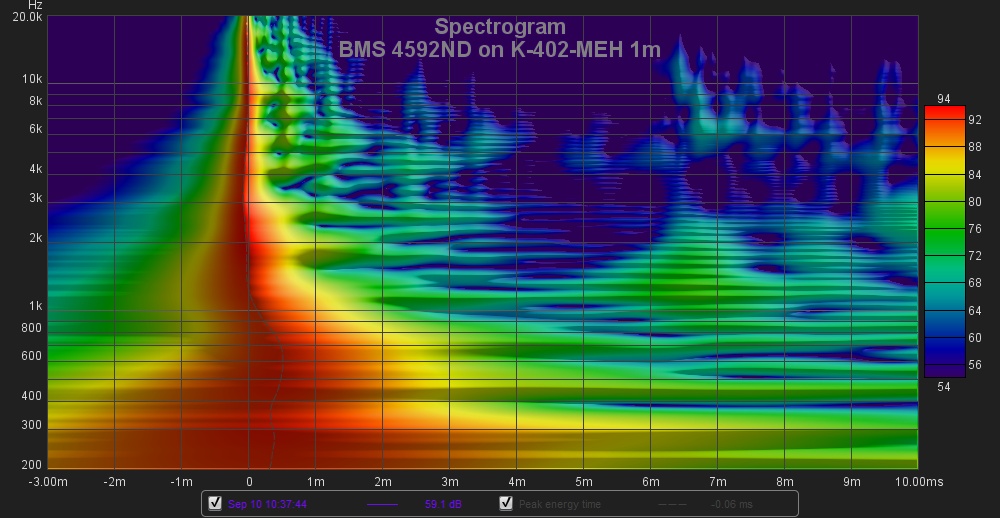
then the TAD TD-4002:
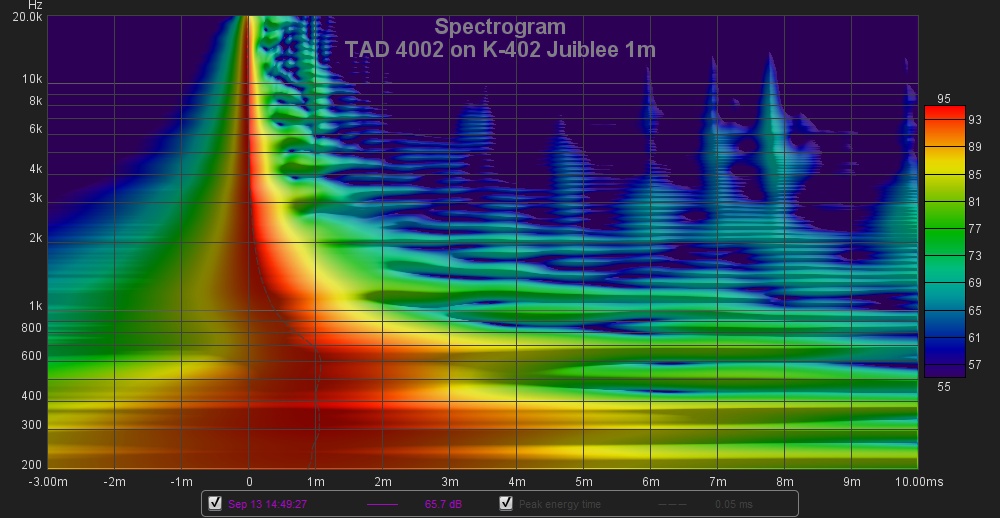
Now the real question is: how much of this difference is audible? For me, it's not. I cannot tell these drivers apart. (That's saying a lot, trust me.)
In terms of the theoretical differences--the BMS dual-diaphragm driver should beat the TAD on high frequency FM distortion (because it breaks the ~400-20000 Hz pass band into two parts, thus avoiding the widely spaced FM sidebands).
The TAD clearly has better dial-in characteristics, only requires one amplifier channel, and the spectrograms look better in comparison. I don't believe, though that this is worth 3x-4x the price, however, since I've already mentioned that I can't hear the difference.
I also need to state that you need to bi-amp, time align, and apply several PEQs per channel with the BMS 4592ND--at least the version that I just bought new this fall. I've dialed in another set of 4592Nds for another guy on K-402s. These drivers are considerably older--more than 10 years--and they required no time alignment...strangely.
As far as other 2" compression drivers: all of the others that I've heard have audible signatures above 10K that give them away (however slight that difference might be--and it can be very small).
I've not heard or measured a Radian 950BePB, however, which I would expect to be a duplicate of the TAD 4002 performance.
Chris
then the TAD TD-4002:
Now the real question is: how much of this difference is audible? For me, it's not. I cannot tell these drivers apart. (That's saying a lot, trust me.)
In terms of the theoretical differences--the BMS dual-diaphragm driver should beat the TAD on high frequency FM distortion (because it breaks the ~400-20000 Hz pass band into two parts, thus avoiding the widely spaced FM sidebands).
The TAD clearly has better dial-in characteristics, only requires one amplifier channel, and the spectrograms look better in comparison. I don't believe, though that this is worth 3x-4x the price, however, since I've already mentioned that I can't hear the difference.
I also need to state that you need to bi-amp, time align, and apply several PEQs per channel with the BMS 4592ND--at least the version that I just bought new this fall. I've dialed in another set of 4592Nds for another guy on K-402s. These drivers are considerably older--more than 10 years--and they required no time alignment...strangely.
As far as other 2" compression drivers: all of the others that I've heard have audible signatures above 10K that give them away (however slight that difference might be--and it can be very small).
I've not heard or measured a Radian 950BePB, however, which I would expect to be a duplicate of the TAD 4002 performance.
Chris
Attachments
Thanks a lot for the elaborated reply!
Best regards
Peter
Best regards
Peter
I believe that two plots will tell you a lot more: impulse spectrograms on a K-402 horn. First the BMS 4592ND (biamped and time aligned):

then the TAD TD-4002:

Now the real question is: how much of this difference is audible? For me, it's not. I cannot tell these drivers apart. (That's saying a lot, trust me.)
In terms of the theoretical differences--the BMS dual-diaphragm driver should beat the TAD on high frequency FM distortion (because it beaks the ~400-20000 Hz pass band into two parts, thus avoiding the widely spaced FM sidebands).
The TAD clearly has better dial-in characteristics, only requires one amplifier channel, and the spectrograms look better in comparison. I don't believe, though that this is worth 3x-4x the price, however, since I've already mentioned that I can't hear the difference.
I also need to state that you need to bi-amp, time align, and apply several PEQs per channel with the BMS 4592ND--at least the version that I just bought new this fall. I've dialed in another set of 4592Nds for another guy on K-402s. These drivers are considerably older--more than 10 years--and they required no time alignment...strangely.
As far as other 2" compression drivers: all of the others that I've heard have audible signatures above 10K that give them away (however slight that difference might be--and it can be very small).
I've not heard or measured a Radian 950BePB, however, which I would expect to be a duplicate of the TAD 4002 performance.
Chris
Hi Chris, great drivers, great looking plots.
(I keep wanting to play with a 4592, I'm using 4594HE's.)
Your 4592 spectrogram looks to me like the lower coax section is leading the upper a bit...
No ????
Oh, and a REALLY stupid question...what's a MEH?
(I keep wanting to play with a 4592, I'm using 4594HE's.)
Your 4592 spectrogram looks to me like the lower coax section is leading the upper a bit...
No ????
Oh, and a REALLY stupid question...what's a MEH?
Last edited:
What horn/waveguide can folks recommend that is better than the 2384? With measurements? I prefer a 1.5" throat and loading down to 500 to 600 Hz. Maybe SEOS-30? SEOS-30 - Horns by Auto-Tech Can't find any polars for it...
What horn/waveguide can folks recommend that is better than the 2384? With measurements? I prefer a 1.5" throat and loading down to 500 to 600 Hz. Maybe SEOS-30? SEOS-30 - Horns by Auto-Tech Can't find any polars for it...
To add to mitchba's question re the 2384....it's a 90x50, right?
And how well does vertical hold pattern? I've read to be wary of pattern flip when H/V exceeds 1.6X.
Round SEOS' are not constant directivity horns. They are beaming.What horn/waveguide can folks recommend that is better than the 2384? With measurements? I prefer a 1.5" throat and loading down to 500 to 600 Hz. Maybe SEOS-30? SEOS-30 - Horns by Auto-Tech Can't find any polars for it...
I don't think you are going to find the "perfect" horn today. They all have their weaknesses. They are either too small, weaknesses in the polars, have the wrong exit, have discontinuities due to sharp edges/neck, are resonant due to poor material, etc.
Klipsch K-402 with a beryllium driver like Radian 950BePB is the best compromise I've heard. Wasn't able to upload the pdf file with measurements. Too big of a file.
That's already been answered.To add to mitchba's question re the 2384....it's a 90x50, right?
And how well does vertical hold pattern? I've read to be wary of pattern flip when H/V exceeds 1.6X.
Not at the crossover frequency (6.4 kHz).Hi Chris, great drivers, great looking plots.
(I keep wanting to play with a 4592, I'm using 4594HE's.)
Your 4592 spectrogram looks to me like the lower coax section is leading the upper a bit...
No ????
This is why I'm working to get a K-402-like profile horn mold going. I'd actually recommend a TAD 4002 throat adapter (1.5-->2 inches) and the K-402 horn for DIY duty presently, but right now the horn is being priced way above its replacement cost from Klipsch (4x higher, in fact).What horn/waveguide can folks recommend that is better than the 2384? With measurements? I prefer a 1.5" throat and loading down to 500 to 600 Hz. Maybe SEOS-30? SEOS-30 - Horns by Auto-Tech Can't find any polars for it...
A K-402-like profile horn could easily be made to 1.5 inch throat dimensions, too, as well as having integral off-axis woofer pads ready for MEH duty. (The user could drill the ports where they want them, or they can be molded in directly.)
Chris
That's already been answered.
yeah, sorry i missed it...
So maybe i can add something other than lame questions...
For 1.4", I really like the bms 4594 with xt1464.
It's supposedly a 60x50, but it sounds narrower to me. I know patterns are quoted at the -6dB point, but I think there is also an order to the rolloff at -6, just like the order on crossovers.
The 1464 cuts off fast at pattern edge.
Here's some off-axis mag plots.
First is horizontal. 0, 10, 20, 25, and 30 deg.
Then vertical 0, 10, 20, and 25 deg.
Attachments
Thanks Omholt and Chris. Looking at the polars for the K-402, I can see why it is a top performer. Chris, thanks for the recommendation on the adaptor, I wonder if it would adversely affect the response? I like your idea of a K-402 like waveguide mold.
Omholt I like your comment on post 63: ...the 2384 is better though than M2.
I wondered about that before when I saw the 800 Hz XO point on a smaller waveguide. You can see the directivity shift on the M2 spins at about 800 Hz:
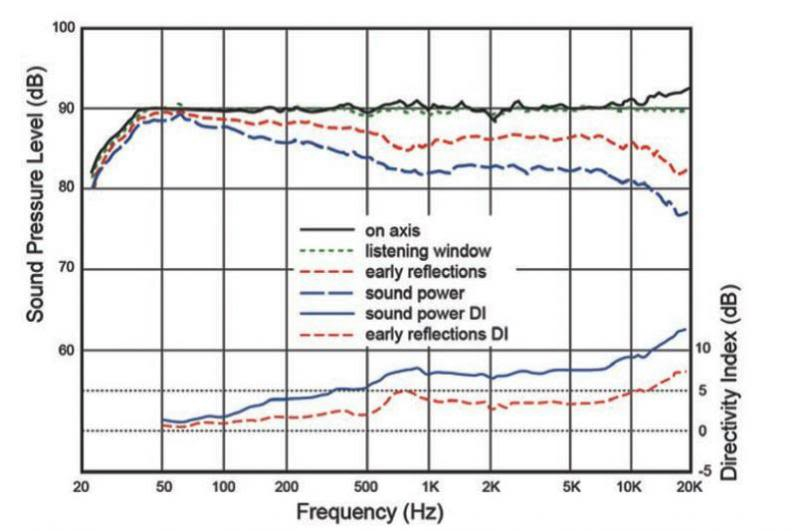
800 Hz is also the M2's XO point, so not sure how much contributed by XO, waveguide or 3" CD? But yah, you don't see that in the 4722 spins...
Omholt I like your comment on post 63: ...the 2384 is better though than M2.
I wondered about that before when I saw the 800 Hz XO point on a smaller waveguide. You can see the directivity shift on the M2 spins at about 800 Hz:
800 Hz is also the M2's XO point, so not sure how much contributed by XO, waveguide or 3" CD? But yah, you don't see that in the 4722 spins...
Attachments
Both the M2 and 2384 get crushed by the old and best bi-radial horns from the 80s.
The butt cheek horn in 4430/35 had amazing polars. However, the horn was small with a too high of a crossover IMO.
YouTube
But hey, the M2 horn looks trick though! And isn't that what's important in the market today?
The butt cheek horn in 4430/35 had amazing polars. However, the horn was small with a too high of a crossover IMO.
YouTube
But hey, the M2 horn looks trick though! And isn't that what's important in the market today?
I don't get the attraction to the 2344 and 2342 horns.
The peaks and dips probably caused by the slot have to be resonances that would show show up on a waterfall plot.
2342 response
JBL2342 Bi-Radial Horn @ AmpsLab
2344
2344
Dispersion is important, i get it.
But not with a bunch of resonances.
The peaks and dips probably caused by the slot have to be resonances that would show show up on a waterfall plot.
2342 response
JBL2342 Bi-Radial Horn @ AmpsLab
2344
2344
Dispersion is important, i get it.
But not with a bunch of resonances.
Last edited:
- Home
- Loudspeakers
- Multi-Way
- 1.4" or 2" throat large constant directivity horns you can actually buy!
